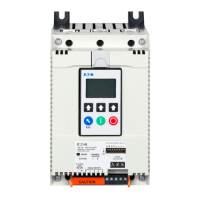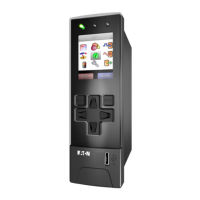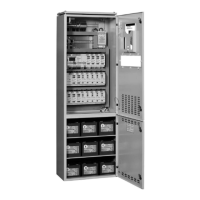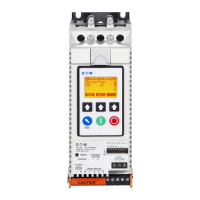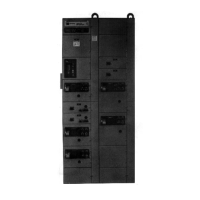S611 Soft Starter MN03902011E—May 2012 www.eaton.com 79
S611 Fault Codes, continued
Code Fault Condition Solution
19 Instantaneous Overcurrent • Excessive starting current
• Excessive load
• Reduce starting load
• Increase soft starter capacity (be sure model ratings
can handle current demands)
Note:
During the start ramp time, the maximum rms value of the three-phase current(s) are monitored. Instantaneous overcurrent trip threshold is 6 X catalog
FLA. The trip delay is 1.5 seconds and is not user settable. Catalog FLA refers to the maximum continuous line current capacity of the S611 soft starter,
NOT the motor rated FLA.
Do not confuse this parameter with Thermal Overload (FC20), SCR Overcurrent (FC27), or Contactor Overcurrent (FC34).
20 Overload • Motor overloaded for an extended
period of time
• Thermal memory is over 100%
• Reduce the motor’s load
• Verify the Overld Trip FLA and/or Ovrld Trip Class for
proper adjustment
• Note: Exceeding nameplate ratings will shorten
equipment life
• Fault during motor start: Verify system is not
exceeding the specified maximum starts per hour
• Increase the initial torque and/or reduce ramp time
to bring the motor up to speed faster
• Increase Trip Class setting (5–30 maximum) and/or
reduce ramp time setting
Note:
Normal thermal memory during routine operation may be observed in the UI display. Higher than normal thermal memory may indicate an abnormal
operating condition and signal an impending Overload fault. After a motor start, the thermal memory should stabilize at a value consistent with the load.
The thermal memory is stored in non-volatile memory so that the overload fault will not be cleared by cycling control power.
21 Mains AC Voltage Loss • Fuses or breaker open
• Disconnect open
• Replace fuses, close disconnect, or reset breaker
Note:
The Mains Loss Fault trip threshold is 80 Vac and is not user settable.
22 Under Voltage • Incoming AC line voltage below trip
threshold
• Incorrect mains supply voltage
• Connect to correct supply voltage
• Verify that mains voltage is within acceptable values
• Verify Motor Rated Voltage in the Operation mode is
set to the correct value
Note:
Verify that the value in the Under Voltage parameter is set to the correct line voltage and not to a nominal value. Under Voltage trip level threshold range
is 1–99% (default 80%) of line voltage. The Under Voltage Trip Delay range is 1–60 seconds (default 10 seconds). This feature may be disabled (not
recommended). Verify that the mains voltage levels are not decreasing to unacceptable levels during motor run operation. Under voltage during the start
ramp time is not monitored. The Motor Rated Voltage range is 115–690 Vac (480 Vac default).
23 Over Voltage • Incoming AC line voltage above trip
threshold
• Incorrect mains supply voltage
• Connect to correct supply voltage
• Verify Motor Rated Voltage in the Operation mode is
set to correct value
Note:
Verify that the value in the Motor Rated Voltage parameter is set to the correct line voltage and not to a nominal value. Over Voltage trip level threshold
range is 101–120% (default 110%) of line voltage. The Over Voltage trip delay range is 1–60 seconds (default 10 seconds). This feature may be disabled
(not recommended). Verify that the mains voltage levels are not increasing to unacceptable levels during the start sequence or during motor run
operation. The Motor Rated Voltage range is 115–690 Vac (480 Vac default). Over voltage during the start ramp time is not monitored. Over Voltage—a
similar fault that may occur if the mains voltage is in excess of 800 Vac.
24
Phase Reversal • Incoming line phase rotation sequence
opposite of device setting
•
Single-phase missing and/or open fuse
or breaker
• Set Phase Sequence to match incoming sequence OR
• Exchange two incoming mains phases
• Verify that all circuit breakers are closed or fuses are
serviceable
Note:
If mains leads need to be changed, exchange incoming leads and set Phase Sequence to match incoming sequence. If an upstream reverser is used,
disable Phase Rev Fault (not recommended). This fault is not uncommon in new installations. In the event of a blown fuse prior to a START command, this
fault may occur as the unit is not able to determine phase rotation with one open fuse. If motor rotation requires exchange of phases, exchange the
cables between the soft starter and the motor.
www.comoso.com

